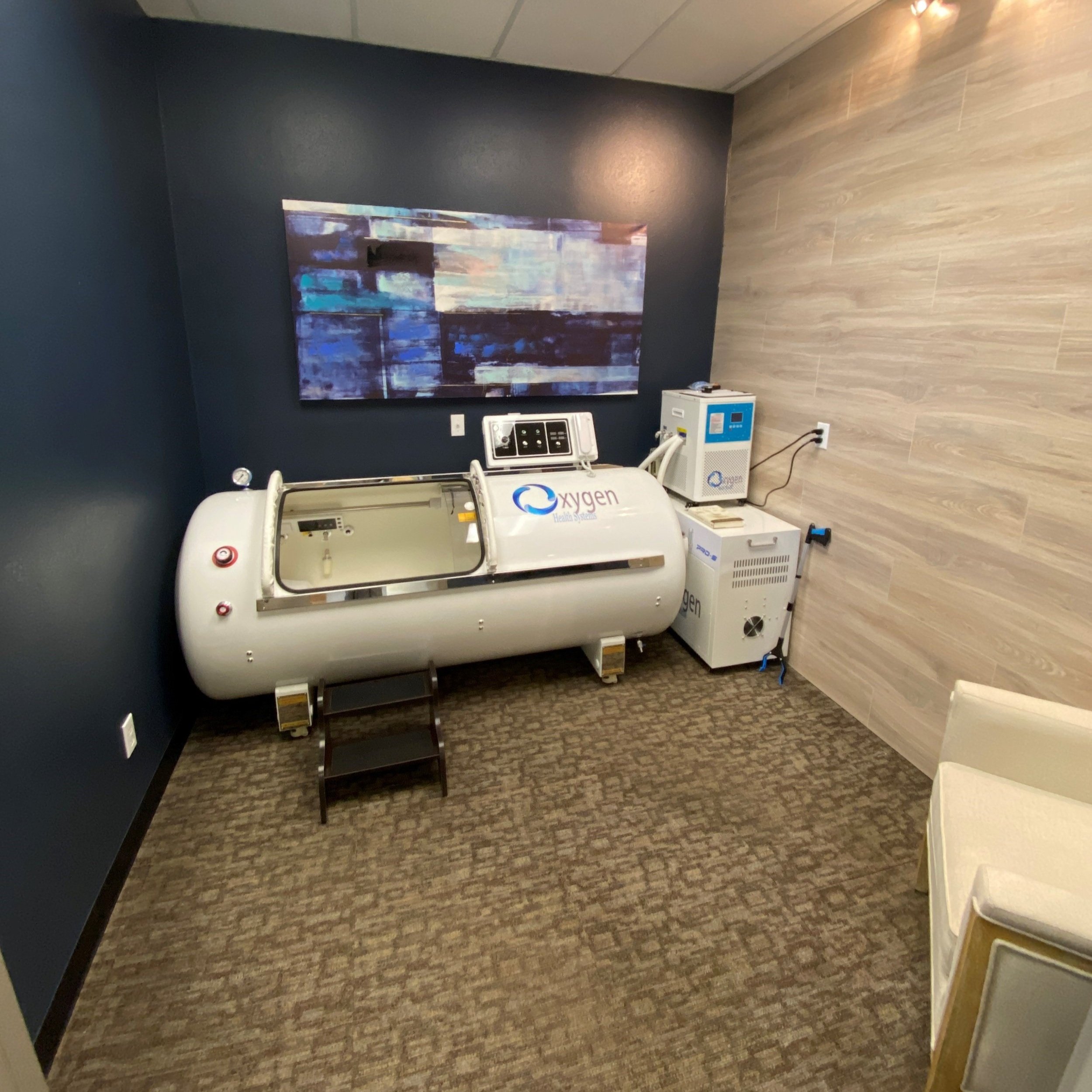Hyperbaric Oxygen Therapy
Sit back, relax, and breathe.
Hyperbaric oxygen therapy (HBOT) is an all-natural, non-invasive treatment where a patient simply breathes 100% medical-grade oxygen at an increased atmospheric pressure. HBOT can increase the oxygen concentration in the body by up to 1,200% —this gives it the potential to lead to extraordinary health benefits.
These benefits include:
Increased Blood Flow
Encouragement of Body Tissue Regeneration
Decreased Inflammation and Inflammatory Proteins
Increased Stem Cell Activation
Faster Bone and Cartilage Regeneration
Reduced Muscle Fatigue and Exhaustion
Increased Mental Focus
Aiding in Fighting Infection
Enhancement of the Body’s Natural Ability to Heal
FAQ’s
What is Hyperbaric Oxygen Therapy?
Hyperbaric Oxygen Therapy is the use of prescribed high pressure oxygen to treat a variety of health conditions and diseases. Breathing pure oxygen under pressures greater than sea level increases the amount of oxygen carried by the blood, enabling the oxygen to be dissolved into the hard-to-reach plasma, lymph, and cerebrospinal fluids surrounding the brain and spinal cord. These fluids more easily carry the increased oxygen to affected and damaged areas at up to 1,200% the normal concentration, thus providing a greater opportunity for healing.
Is Hyperbaric Oxygen Therapy Right For You?
Hyperbaric Oxygen Therapy is an effective treatment for a variety of medical conditions either as a primary or adjunctive treatment. It is non-invasive with very few potential side effects and has very few contraindications.
What Medical Conditions Are Treated with Hyperbaric Oxygen Therapy?
Hyperbaric Oxygen Therapy is beneficial in treating a variety of medical conditions. The FDA currently recognizes Hyperbaric Oxygen Therapy for the following medical conditions, many of which are generally covered by insurance.
• Air or Gas Embolism
• Carbon Monoxide Poisoning and Smoke Inhalation
• Central Retinal Arter Occlusion
• Chronic Refractory Osteomyelitis
• Crush Injury & Other Acute Traumatic Ischemias
• Decompression Sickness
• Diabetic Lower Extremity Wounds
• Failed Skin Grafts & Flaps
• Gas Gangrene
• Necrotizing Soft Tissue Infections
• Non-Healing Wounds
• Radiation Tissue Damage
• Sever Acute Anemia
• Sudden Sensorineural Hearing Loss
• Thermal Burns
In addition, there are many other medical conditions that research has demonstrated efficacy. However, these are generally not covered by insurance.
• Anoxic Brain Injury
• Arthritis
• Canger
• Cerebral Palsy
• Chronic Fatigue Syndrome
• Complex Regional Pain Syndrome
• Complications of Scleroderma
• Concussion & Traumatic Brain Injury
• Crohn’s Disease
• Fibromyalgia
• Inflammatory Bowel Disease
• Interstitial Cystitis
• Long COVID
• Lyme Disease
• Migraine/Headache
• Multiple Sclerosis
• Pancreatitis
• Retinitis Pigmentosa
• Spnal Cord Injuries
• Sports Injuries
• Stroke
• Surgery Preparation & Accelerated Recovery
• Ulcerative Colitis
What Does Hyperbaric Oxygen Therapy Feel Like?
At the start of the treatment session, oxygen immediately begins to circulate, and the pressure gradually increase. The patient will generally start to feel a fullness sensation in the ears, similar to ascending or descending in an airplane. This fullness should only last about 10 minutes and a member of our staff will guide the patient to relieve any ear pressure. Once treatment pressure is reached, patients relax and just breathe normally. Near the end of the treatment session, the staff member will gradually decrease the pressure in the chamber, a process that lasts about 10 minutes. During this decompression stage, it is common for patients to experience a slight popping sensation in the ears as a result of the change in pressure.
Are There Any Side Effects Associated With Hyperbaric Oxygen Therapy?
Hyperbaric Oxygen Therapy is an all-natural therapy with generally no, or temporary, side effects. However, mild irritation to the ear drum may occur in about 10% of patients. The staff at Discover Wellness will be with you every step of the way to prevent this from occurring. Other side effects may include temporary vision changes, dizziness, or lightheadedness. In very rare instances, oxygen toxicity may occur, however, risk of this is mitigated by our HBOT protocols and comprehensive patient screening process.

